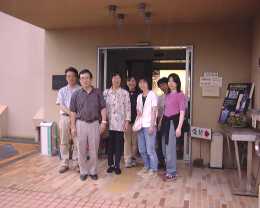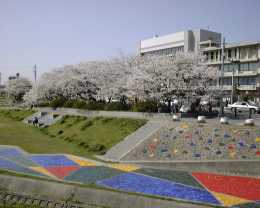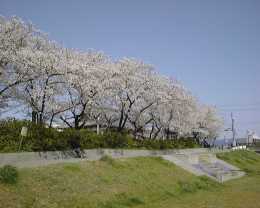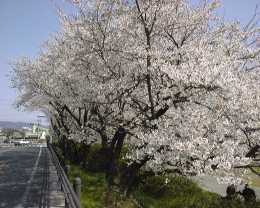 |
 |
瀬戸市歴史民俗資料館と瀬戸市役所前の瀬戸川沿いの桜
|
| 《2005年10月7日追記》 瀬戸市歴史民俗資料館は機能を終えて、「瀬戸蔵」3階・4階の「瀬戸蔵ミュージアム」 へその機能が拡張され移行された。 |
| 瀬戸市歴史民俗資料館のエントランス (2002年3月30日
- 1回目) (後列中央はナイジェリア人サミュエル・オコンガ氏) Entrance of Seto City Folk Historical Material Museum (Mar. 30, 2002) (Mr. Samuel Okuonghae from Nigeria in the rear center) |
 |
瀬戸市歴史民俗資料館のエントランス(2002年6月29日 - 2回目) Entrance of Seto City Folk Historical Material Museum (June 29, 2002 - 2nd time) |
| 瀬戸市文化センター開館20周年記念特別展として、歴史民俗資料館収蔵の作品も 含めて瀬戸市が収蔵する美術品が瀬戸市文化センター(入場料200円)を中心に 歴史民俗資料館(入場料100円)及びマルチメディア伝承工芸館(無料)で展示されています。 As a memorial special exhibition, wok of arts which Seto city houses including work of arts City Folk Historical Meaterial Museum houses are exhibited at Seto City Culture Center as a main place, Seto City Folk Historical Material Museum and Seto Municipal Center of Multimedia and Traditional Ceramics. 第2回目訪問により次の事を確認できました。 1 瀬戸の窯及び陶器の時系列的分布状況 窖窯(古墳時代〜鎌倉時代13世紀;須恵器、山茶碗、古瀬戸)→大窯(室町時代16世紀; 天目茶碗、銅緑釉)→連房式登窯(安土桃山16世紀〜江戸時代17〜19世紀) 2 陶器の生産工程 1)採土 2)製土 3)ロクロ成形 4)タタラ成形 5)乾燥 6)絵付(下絵付と上絵付が あるが瀬戸は主として下絵付)、7)施釉 8)焼成(酸化炎焼成;中世炎焼成; 還元炎焼成) 9)運搬 3 釉薬の材料と対応する焼成された陶器 |
| ガス窯(注1) | 第2回目訪問 |
 |
 |
| 注1 歴史民俗資料館玄関横にあるこのガス窯はノベルティ製作で有名だった丸山陶器が 所有していたもので、昭和35年9月瀬戸で最初に導入されたガス窯である。 (展示説明板より引用) |
| 瀬戸川沿いの桜 1 Cherry blossom along Seto River |
瀬戸川沿いの桜 2 Cherry blossom along Seto River |
瀬戸川沿いの桜 3 Cherry blossom along Seto River |
 |
 |
 |
| 瀬戸川沿いの桜 4 Cherry blossom along Seto River |
瀬戸川沿いの桜 5 Cherry blossom along Seto River |
瀬戸川沿いの桜 6 Cherry blossom along Seto River |
 |
 |
 |
| 瀬戸市歴史民俗資料館 国指定の重要有形文化財”瀬戸の陶磁器の生産用具及び製品(3,943点)を含み、質量共に 日本一を誇る陶磁器に関する資料を収蔵・展示しています。建物の中に3箇所の展示室や 昔の瀬戸焼の生活用品や瀬戸焼の運搬道具等の展示コーナー、当資料館制作のビデオ コーナーがあります。 又、屋外には瀬戸で最初に使われたガス窯が展示されています。 第1展示室: 瀬戸焼の生産に使われた昔の道具等を工程順に展示 第2展示室: 各時代の特徴ある製品を展示し瀬戸焼の歴史をたどる 第3展示室: 企画展を開催する−2002年2月16日〜5月26日はセト・ノベルティ(注)を展示 (以上、当資料館の案内パンフレットを参照) 注: セト・ノベルティは装飾的な陶磁器製品、例えば置物、小物入、煙草入、香水瓶等の製品の 総称。 最も親しまれているノベルティは人形、鳥、動物等の置物。 今回の展示は1970年代 〜1990年代初頭までの鳥、動物を中心としたノベルティを展示しセト・ノベルティの歴史の 一端を探ろうとするもの。 セト・ノベルティの生産の歴史・海外からの買付け・生産工程は別画面を参照して下さい。 Seto City Folk Historical Material Museum This museum owns and displays the most and the best materials related to ceramics in Japan including ceramic production tools and products in Seto (3,943pieces), which are designated as national important tangible assets. There are three exhibition rooms, two exhibition spaces - one is inside the building for utensils and carriage in the past, the other is outside the builiding for Gas kiln, and Video display booth. Exhibition
Room No. 1: |